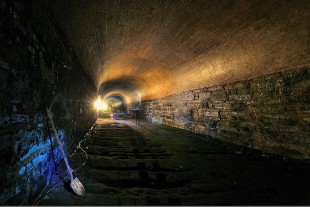Cobble Hill Tunnel, Cobble Hill, Brooklyn, NY

As you wander the streets of Cobble Hill, Brooklyn, it’s easy to miss the hidden gem beneath your feet: the Cobble Hill Tunnel. This tunnel has a rich history, essential to New York’s industrial past and transportation system.
Constructed in the 1840s as part of the Brooklyn and Jamaica Railroad, the tunnel was designed to transport goods between Long Island and New York City. At nearly a mile long and 25 feet wide, it was one of the most enormous tunnels of its time.
Despite being closed for over 100 years, this tunnel has become a popular spot for urban explorers looking to uncover its secrets. So why not join them on their quest and discover what makes this tunnel such an intriguing part of New York’s past?

The History of the Brooklyn and Jamaica Railroad
The early operations of the railway were focused on transporting goods, such as lumber and produce, between Brooklyn and Jamaica.
However, with the completion of the Long Island Rail Road in 1844, the Brooklyn and Jamaica Railroad began to expand its passenger services.
By the late 1800s, it had become a vital link for commuters between these two bustling areas of New York City.
As railway expansion continued throughout the city and suburbs in the following decades, so did this historic railroad's influence and importance.
Construction of the Cobble Hill Tunnel
Don’t miss out on the fascinating history of this engineering marvel. Workers labored tirelessly for years to construct a passage connecting two bustling neighborhoods. The construction of the Cobble Hill Tunnel was no easy feat. Excavating through solid rock and navigating underground waterways were just some of the engineering challenges those who worked on it faced.
Despite these obstacles, the tunnel was completed in 1844 and opened up new opportunities for commerce and transportation between Brooklyn and Manhattan. Today, it is a testament to human ingenuity and determination, reminding us of what can be accomplished with hard work and perseverance.
Features of the Tunnel’s Design
As you walk through the dark, winding passage, you can’t help but marvel at the intricate brickwork and impressive arches that make up the Cobble Hill Tunnel’s design.
The lighting design is strategically placed to highlight these features while providing enough illumination for safe passage.
Additionally, the ventilation system ensures that fresh air circulates throughout the tunnel, keeping it free of pollutants and maintaining a comfortable environment for those passing through.
These elements are essential in creating a functional and aesthetically pleasing underground structure that has stood the test of time.
The Tunnel’s Role in New York’s Industrial Past
Exploring the history of New York’s industrial past reveals the significant role of the Cobble Hill Tunnel in facilitating transportation and trade. The tunnel was constructed during the Industrial Revolution when transportation advancements were crucial for economic growth.
It enabled trains to travel between Brooklyn and Manhattan, carrying goods such as coal, oil, and grain. This increased efficiency allowed businesses to expand their markets, leading to a thriving economy in New York City.
The Cobble Hill Tunnel was an impressive feat of engineering at the time, with its arched brick ceiling allowing for more excellent stability and support for heavier loads. As you explore this underground structure’s history, it becomes clear how vital it was in shaping New York’s industrial past.
Exploring the Cobble Hill Tunnel Today
Nowadays, wandering through the dimly lit underground passageways of the Cobble Hill Tunnel in Brooklyn, NY, it’s easy to imagine the hustle and bustle of trains carrying goods between bustling urban centers.
While the tunnel no longer serves its original purpose, it has become a hidden gem for urban exploration enthusiasts looking to discover a piece of New York City’s industrial past.
As you make your way through the dark and eerie tunnels, you can’t help but feel a sense of adventure and excitement as you uncover remnants of its history.
Something is intriguing around every corner, from old train tracks to graffiti art.
Whether you’re a seasoned explorer or just looking for a unique experience off the beaten path, exploring the Cobble Hill Tunnel is an unforgettable journey that will transport you back in time and leave you with memories that will last a lifetime.
Frequently Asked Questions (FAQ's)
How much did it cost to build the Cobble Hill Tunnel?
You might be interested that the cost estimation for building the Cobble Hill Tunnel was around $2.5 million in 1903. Funding sources included public and private funds, such as city appropriations and bond issues.
Were there any accidents during the construction of the tunnel?
During the construction of the Cobble Hill Tunnel, there were several accidents due to poor construction safety and worker conditions. Workers faced long hours, dangerous equipment, and cramped spaces, which led to injuries and fatalities.
How long did it take to complete the construction of the tunnel?
During the construction timeline of the Cobble Hill Tunnel, workers faced harsh conditions and numerous setbacks, including flooding and cave-ins. Despite these challenges, the tunnel was completed in approximately four years.
What type of materials were used to build the tunnel?
Construction materials for the Cobble Hill Tunnel included brick, limestone, and granite. The tunnel design utilized a double-track system and incorporated ventilation shafts to ensure proper airflow. These elements ensured durability and safety for train transportation.
How did the tunnel impact the local community during its construction and after its completion?
You’ll be interested to know that the Cobble Hill Tunnel had a significant impact on the local community. During its construction, it created jobs and brought economic growth. After completion, it provided a faster transportation option, benefiting residents and businesses in the area. Community involvement was also critical in ensuring the success of this project.